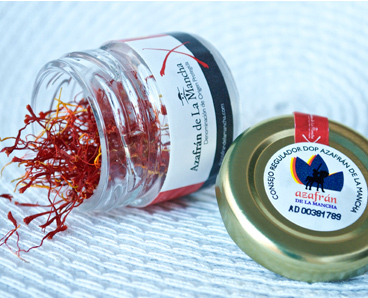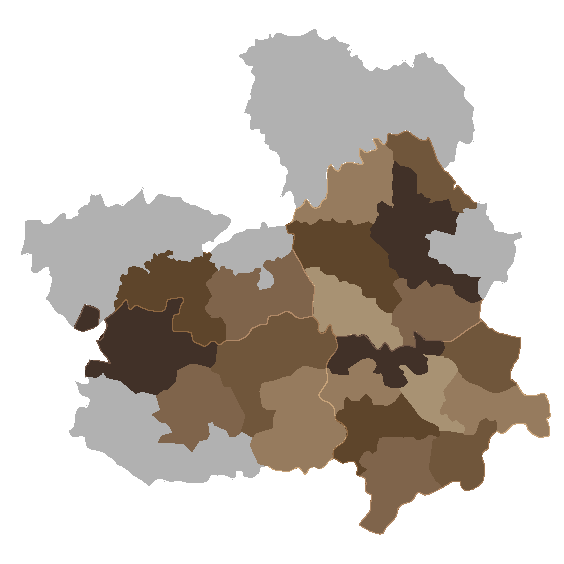Municipios de la Comarca de Almansa
- ALCADOZO
- ALMANSA
- ALPERA
- BONETE
- CAUDETE
- FUENTE-ALAMO
- MONTEALEGRE DEL CASTILLO
The saffron under the PDO La Mancha Saffron quality seal, is the only spice of this nature with this recognition of quality in Spain. The specific requirements which must be meet are included in a document, Product Specifications which has been approved by the European Commission. All producers and canners in the marketplace must meet the product specifications. An independent and impartial control Agency verifies that the producers and canners, each in its area of activity, meet the Product specifications. This control Agency has been authorised by the competent authority and approved by ENAC (Spanish Accreditation Body) under the UNE-EN ISO/IEC 17065 Standard or standard which supersedes same.
The main characteristics of the PDO La Mancha Saffron are:
The PDO La Mancha Saffron constitutes in itself a triple guarantee: Spanish origin saffron; highest quality colour, flavour and aroma; and a comprehensive control system which eliminates any risk of exposure in the product.

The Saffron under the PDO La Mancha Saffron is marketed exclusively and packaged in containers not exceeding a net weight of 100 grams, and must always be packaged and marketed the year prior to its packaging. The saffron must be stored and protected from moisture, light and at a temperature below 25ºC.
The authorised companies to package the saffron under the PDO La Mancha Saffron have efficient self-control systems, which ensure that the marketed saffron meets all product specification requirements with regard basically to the physicochemical and organoleptic qualities. Furthermore, every packaging company is audited yearly, this audit is carried out by an authorised control Agency which has been approved by ENAC (Spanish Accreditation Body) under the UNE-EN ISO/IEC 17065:2012 Standard and authorised by the Agrifood Department of Castile La Mancha, dependent upon the continuation of its authorisation to continue packaging the La Mancha Saffron.
The labelling of the saffron under the PDO La Mancha Saffron clearly shows the numbered Regulatory Council back label, and includes the packaging and use-by dates, according to the prevailing legislation.

The process of drying applied to the stigmas which are obtained from the plucking process is a crucial stage in the manufacture of the saffron under the PDO La Mancha Saffron, as it plays a determining role in:
The harvested flowers immediately undergo separation of stigma from flower or plucking of the saffron stamens process. Temporarily, and until the flowers are spread out, to prevent the risk of being crushed, on a dry and absorbent surface.
The process of plucking the stigmas is a manual process which requires expertise. It is carried out by pinching and breaking the style where it is white. The three stigma of the saffron flower obtained in this fashion are placed into a container until to the next stage of the process, drying.
The weather conditions of the production area of the saffron under the PDO La Mancha Saffron make the flowers bloom between the second fortnight of October and the first fortnight of November.
Daily, during this period, while the process lasts, the flower, in any state of the opening of the corolla, is harvested, in consecutive rounds in the saffron field.
The labour is carried out during the first hours of the day, avoiding the heat of the day, until all the flowers that bloomed the night before have been harvested. The flowers must be harvested by means of a strong and precise tweak, carried out in the area of the union between the stem and the calyx.
The cut flowers are gently placed, to prevent the risk of being crushed into containers, which allow ventilation, traditionally wicker baskets. These containers are protected from direct sunlight and are immediately taken to the separation of stigma from flower process.
From the Mediterranean, saffron very likely arrived with the Phoenicians, Greeks and Romans, but it was the Arabs who were mainly responsible for its expansion throughout the entire Iberian Peninsula. Nevertheless, the saffron adapted itself in a very particular manner to the soil and climatic conditions and sustainable human intervention of La Mancha, and is, much like El Quixote an intrinsic part of its identity and culture. See Map
For several centuries, La Mancha producers have implemented a simple technology, which in essence has remained unchanged until the present day, wherein the family has a major presence in the simple and sober tasks that the preparation of this precious spice requires. Just like that, La Mancha Saffron transcended its mere production, and became the driving force of social relationships through the ties of neighbourhood, cooperation and solidarity on which its exploitation has been built.
Famed for many centuries for its high quality, the La Mancha Saffron was praised by travellers, writers and other vestiges of the past as “a noble seed and of great value”. For example, Alexandre Dumas in the nineteenth century referred to La Mancha as “the country of saffron, where one finds lakes of flowers making up the richness of the steppe, serving at the same time for its embellishment and decoration”.
Ceremonies and symbols as regards La Mancha Saffron still survive in the villages, meeting ideological functions and social cohesion, which imbue an added value to the recognised quality of this very characteristic product.
